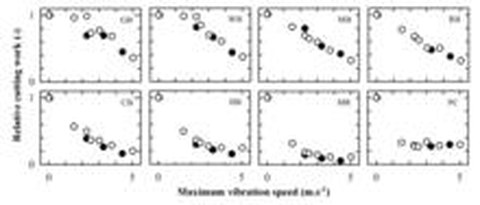Rheological limitations in ultrasonic cutting of foods
When cutting foods with sensible structure, or products with enhanced compressibility, high elasticity or adhesivity, conventional cutting devices are frequently of limited use. However, ultrasonic supported cutting techniques might improve the applicability of the process in selcted cases. Aim of the project was to identify limitations of ultrasonic cutting from both a qualitative and quantitative point of view. In ultrasonic cutting, the relative cutting speed between product and device is superimposed by a high-frequency vibration of the blade. The extremely high strain rates induced by ultrasonic excitation and the periodic changes between debinding and contact of cutting sonotrode and product are considered as responsible for reducted product deformation and high quality cuts.
The effects on the cutting efficiency is based on the complex interaction between blade vibration and chemical, physical and biological properties of the cut product. Both rheological properties and the release of lubricating fluids (water, fat) at the edge of the blade lead to a reduction of friction and, consequently, the appearance of the cut face is improved. Problems arise when applying ultrasonic cutting to instable, thermolabile foods which are sensitive to cavitation. A proper selection of the blade geometry and of the direction of ultrasonic excitation as well as a proper adjustment of frequency, amplitude and cutting speed may improve the results, thus leading to optimum cutting results.
Supported by:
- German Science Foundation (DFG), Berlin
Project researchers and contact:
Former research assistant
NameDr.-Ing. Yvonne Schneider
Send encrypted email via the SecureMail portal (for TUD external users only).
 © Sven Ellger
© Sven Ellger
Research Assistant
NameDr.-Ing. Susann Zahn
Food Process Engineering, Product Development
Send encrypted email via the SecureMail portal (for TUD external users only).
 © Tobias Ritz
© Tobias Ritz
Senior Professor for Food Engineering
NameProf. Dipl.-Ing. Dr. nat. techn. habil. Harald Rohm
Send encrypted email via the SecureMail portal (for TUD external users only).

